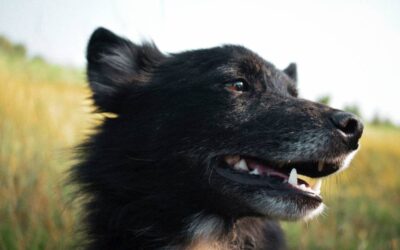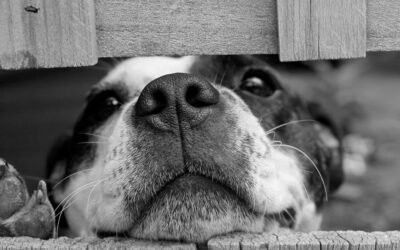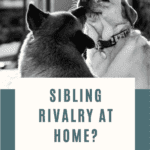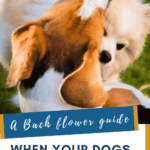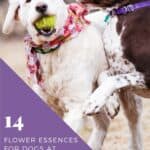If your dogs’ sibling rivalry has gotten out of hand; if they fight occasionally – or even hate each other – flower remedies are a natural therapy that can help them get back to getting along better.
Natural remedies like flower essences can be very helpful in settling down and re-balancing extreme emotions in animals. And that includes helping calm tensions when family dogs are fighting.
Flower essences are a wonderful supplement – safe and surprisingly effective – which can definitely ease the process of getting your dogs friendly with one another again.
But they won’t replace the work that needs to be done; they won’t magically transform your dogs from wanting to tear into each other one moment, to getting along peaceably the next.
Flower essences should be looked at as a support and aid to the necessary training, behavioral work, and careful management required when you’re hoping to rehabilitate your dogs’ relationship.
In this article, I’ll give an overview of how to get dogs that don’t get along back to being buddies (or at least not hating each other), and will go into which Bach flower remedies and specific flower essence blends can help repair the relationship between dogs in the home that fight.
Introduction
The question came via our Facebook page: “I have two dogs that can’t stand each other and fight any chance they get. They used to get along fine. Now, we have to keep them separated always. Can flower essences work to stop my dogs from fighting and hating each other?”
This is one of those tough questions that can’t be answered with a simple yes or no. I am both a dog trainer and flower essence practitioner, and have to answer from both those perspectives.
My flower essence practitioner side says: Yes, absolutely! Flower essences can help tremendously to balance out the raging emotions of two dogs that fight. In my experience, they can tip the balance between success and failure.
If you’re looking for a natural aid to help settle your dog’s bad feelings and open them up to better, more cooperative, less angry behavior, flower essences are a great way to go.
My dog trainer side rushes to add: But — If you’re hoping to repair the relationship between your dogs once they’ve starting fighting, maybe even hating each other, it’s important that you go into this with your eyes open.
Depending on the severity of the fighting, you have to expect not only to manage and control your dogs’ interactions and access to one another for awhile, you should also plan on doing some training and behavior work with both dogs.
This is one of those issues where it’s important to look at it holistically, from all sides.

Can dogs that fight with each other learn to get along?
If you have dogs at home that have started fighting with one another, you won’t know until you try if your dogs can get along again. But before you decide to make the effort involved, there are some important questions to ask yourself.
Have the fights been all noise and spit? That is, no physical damage, or only very minor and seemingly accidental?
If there have not been injuries, or they have been superficial, the chances of fixing the problem can be quite good. It may take a few weeks or months to get there, but dogs that have previously fought can learn to see each other in a new, friendlier light.
On the other hand, maybe there have been emergency vet visits involved.
If one or both dogs have been seriously hurt, your chances of fixing the problem go down significantly. Usually this means one or both dogs are now seriously fearful, and one or both dogs are driven to get rid of the other (which sounds awful, but can happen).
When dogs are determined to hurt each other, it’s not only a matter of putting the work in to change attitudes. There are risks involved in simply working through the issue.
What if someone doesn’t quite latch a door? Or forgets that one dog is inside/outside when switching dogs? Or (fill in the blank)?
When deciding whether to work with dogs in the home that fight, safety must be a top priority.
Ask yourself: if things don’t go as planned, are there factors that could make it unsafe for one or both dogs? Is one dog significantly larger, stronger, more confident, healthy or robust than the other? If so, that can be a dangerous situation to play around with, if you are not 100% sure you can keep the dogs safely separated when fights are likely to occur.
If the risk of serious injury is high, and you’re not sure you can separate the dogs without slip-ups, or if doing so is more work than you can realistically take on, it may be simpler and kinder to find a good home for one of the dogs.
Assuming you’re reading this because you feel hopeful about repairing the relationship of your squabbling dogs, and/or you feel you have a solid system in place to keep them from hurting each other while you’re working on it, let’s get to what’s involved.
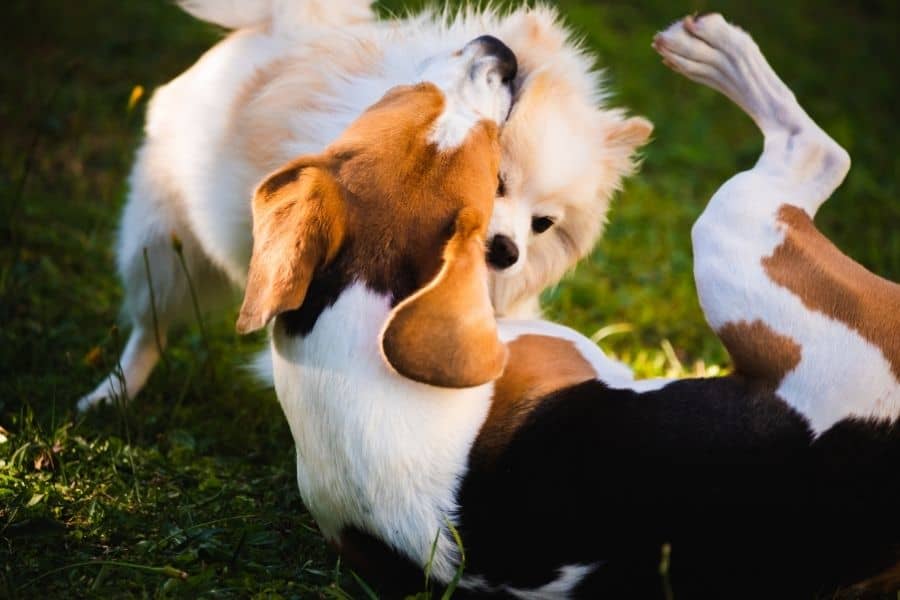
Fixing aggression between dogs at home: what’s involved?
This article is not meant to be an in-depth guide to fixing aggression between dogs that live together. For that, I will post some helpful resources below for you to investigate. But if you’re considering flower essences for your dogs that fight, you need to have at least a basic idea of what’s involved.
The particulars will vary according to the individual dogs and circumstances, but the process of stopping two family dogs from fighting generally goes like this:
1) Start with a cooling off period to let raging emotions die down. This can take longer than you think. Two weeks if the fights have been quick to begin and end, and no one has been hurt. Longer if the fights have been more serious and intense.
During this time, keep the dogs apart and brainstorm to identify problem situations, triggers, and contributing factors. Unless the situation has progressed to the point where your dogs start fighting upon sight of each other, usually there will specific situations and scenarios that trigger fighting. Once you know them, you can avoid or manage the triggering situations while emotions are cooling down.
2) After the cooling off will be a period of strict management with an eye to preventing conflict. It starts with absolutely no possibility of contact during triggering situations. Over time, limited freedom can be given in less-problematic situations (i.e., those that haven’t triggered fights in the past).
As your dogs improve in their attitudes, more freedom can be given. This usually means less physical separation and more voice control, etc. Depending on the severity of the fights, this could be a long stage – months or longer.
3) Train to address any behavior issues. How much training and behavior work will be required depends on the dogs and situation. Most dogs will benefit from the added structure and leadership that comes with some basic obedience training (or obedience refresher, if the dogs have some foundation already).
Often, a lack of structure and understanding of house rules plays into fights between dogs at home, so establishing sensible house rules and training to make sure they’re followed is a very important step in stopping dog fights for good.
4) When the dogs can be around each other without glaring, growling, etc., the creation of positive associations is very important. This will mean engaging in peaceful, happy, enjoyable activities that only happen when your dogs are in each other’s presence.
For dogs whose fighting is limited to very particular situations, this is easy to set up and accomplish. If your dogs’ bad feelings have progressed to where they hate each other on sight, it will take more thought and creativity in the beginning.
This is, admittedly, a very quick outline of what needs to happen to repair your dogs’ relationship. Be sure to check out the resources below for more detail and suggestions:
- Dogs Fighting in Your Household: very thorough article by Whole Dog Journal
- Dog Behavior Problems – Aggression – Sibling Rivalry: article by veterinarians Debra Horwitz, DVM, DACVB & Gary Landsberg, DVM, DACVB, DECAWBM
- Interdog Aggression – Managing Problems Between Household Dogs: good article by Aztec Animal Clinic
- Aggression Between Dogs in the Same Household: Stanley Coren’s take in Psychology Today
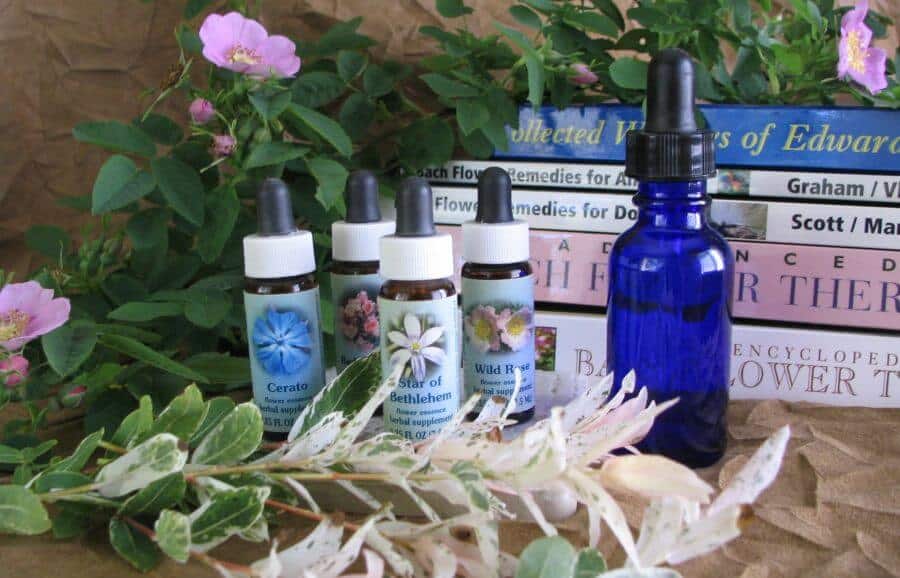
Bach flower remedies for dogs in the home that fight
Flower essences, such as Bach flower remedies, balance emotional tendencies that have gotten extreme or “off” in some way or other. So, in order to choose the best flower essences to help resolve dog fighting issues, we need to look at what emotions might be involved in the fighting.
And when dealing with two dogs fighting or that dislike or hate each other, we need to be sure to look at each individual dog’s feelings and reactions, and try to see what motivates the fighting for each dog. (It may be similar for each dog, or it may not.)
Rescue Remedy. This famous blend of five Bach flower remedies is very helpful in relieving excess stress in traumatized dogs. It also relieves lower level day-to-day stress to a degree. Rescue Remedy can also help heal emotional residue of past trauma and abuse, so if it doubt, include Rescue Remedy!
Holly. If dogs are fighting, it’s a given that one or both dogs is angry. Holly is the Bach remedy to restore more gently, peaceful emotions of the heart. It remedies out of balance heartfelt emotions of vexation, like anger, suspicion, jealousy. If family dogs are fighting, be sure to include Holly.
Mimulus. When family dogs are getting into fights, fear often is part of the picture. Either one dog is fearful and the other is taking advantage of its vulnerability, or one or both dogs may become fearful of the other after minor scraps turn into more serious fights. Mimulus Bach flower remedy reduces fear and anxiety, and improves courage and confidence.
Chicory. Some fights seem to occur always around a certain person or people. If they are close by, or if they give attention or affection to one dog versus another, a fight breaks out. When the object of competition is a person, this is more than simple “resource guarding”. Human beings, unlike inanimate objects, have relationships with dogs. There is typically something out of balance in the relationship when dog fights are triggered by the presence of a (usually particular) person. Chicory remedies possessive, jealous guarding of an individual.
Heather. When excessive attention-seeking, and a strong desire to be the center of attention is motivating one or both dogs, Heather is the flower essence to help. It helps your dog be engaged and empathetic without constantly making everything about them. Heather is commonly paired with Chicory.
Vervain. Dogs that are high energy or high intensity can get just plain annoying to other dogs in the home. They never seem to know when to stop. They harry and relentlessly annoy their canine siblings. If they’re the responsible type, they might “help out” by getting involved when you get after the other dog for breaking some house rule. (Some dogs will act on their own, not waiting for you to lead the way.)
Dogs like this can be fantastic once they learn appropriate outlets, but until then, are very capable of starting fights due to their natural intensity and know-it-all attitude. Vervain can help temper this personality trait to tone it down and take the edge off the overly intense, driven part of it.
Impatiens. Certain breeds, and certain life stages (can we all say “adolescent dogs”) tend to be pushy and impatient. These dogs aren’t looking to boss others around as much as simply moving through life at a mile a minute. If they could talk, their favorite phrase might be, “how about now?”. Impatiens is a wonderful Bach flower remedy for calming and increasing patience and cooperation in blast-through-life dogs that may be getting on the nerves of more settled, less impulsive family members.
Vine. High intensity, impatient dogs may turn to bullying and threats – even force – to get their way or make a point. This may be the dog’s nature, or he could be going through a status-seeking phase. Vine flower essence remedies forceful, domineering, bullying attitudes and behaviors in dogs. In my experience, it seems to open the dog up to improved, more peaceful communication of their needs. This can be a huge help in reducing tension between dogs in the home that fight. Vine is frequently combined with Vervain and Impatiens.
Rock Water. This Bach flower essence addresses similar attitudes to Vine, above, but the motivation is slightly different. Dogs that will benefit from Rock Water are typically sensitive to territory and arbitrary rules. If another dog infringes on these, the reaction tends to be kind of a simmering aggression, with stiff body language, hard glares, threatening posture.
Rock Water softens rigid, territorial tendencies. It increases emotional and physical flexibility, open-mindedness, and gentleness. Use Rock Water when dog fights get started because one dog is too close to another’s bed or other favorite spot, when one dog enters an area the other is already in, when one dog “sets traps” for the other dog by placing bones or other high value items in traffic areas, etc.
Beech. Dogs with a testy, grumpy, intolerant attitude don’t often start fights, but their nit-picky behavior can trigger other dogs who have had enough of “walking on eggshells”. Beech flower essence restores tolerance and empathy in easily annoyed and aggravated dogs.
Willow. Resentment – over attention, privileges, etc. – can be an important emotion in dogs prone to squabbles, dust-ups, and outright fights. Willow restores equable temper in sulky, resentful dogs that take their bad moods out on others.
Cherry Plum. Some reactions seem to explode out of nowhere, completely out of proportion to the situation. Cherry Plum improves self-control and reduces uncontrolled emotional outbursts in intense, high strung dogs, as well as stressed, panicked dogs.
Agrimony. Happy-go-lucky dogs that love peace in the home may get upset, stressed, and agitated when family members argue or even just raise their voices. These dogs may cower, cringe, or run away and hide from perceived conflict and tension. Stressed, anxious dogs tend to be the target of aggression from more confident, bossy dogs. Agrimony restores inner peace in dogs that over-react to stress and conflict in the home.
Walnut. Some dogs can be so sensitive to the stress, emotions, and energy of those around them that they absorb this outside energy into themselves and become influenced by it. Walnut acts as an energetic buffer of sorts to strong energies that can sway emotions and attitudes.
Once you’ve decided on the main flower remedies to help each dog, you can purchase them individually locally or online, and blend them yourself to give to your dogs.
Aldaron Bach flower blends for dogs that don’t get along
Regarding the flower essence formulas mentioned below: Aldaron Essences’ online store closed permanently on May 31, 2023. I no longer sell flower essence formulas directly to customers.
However, in the coming weeks, I’ll be adding new pages detailing some of my most popular flower essence formulas for dogs. These pages will replace the old links to those products on the store. Thanks for your patience during the transition!
Best,
julie
Although it’s important to select flower remedies that will target the emotions for your dogs, and not hypothetical dogs, there are some Aldaron Essences formulas that stand out as having a good track record in this area.
Keep in mind you may need a formula for each dog. It’s not too common to find two dogs that fight who each have the exact same set of emotions.
Harmony. This Bach flower blend is actually my one blend that is designed to help scrappy, squabbling, snarking, fighting dogs in the home. It targets all the ugly, negative emotions often involved in fighting and animosity among family dogs: anger, jealousy, resentment, frustration, irritability, nit-picky intolerance. And since this fighting is happening in the home, it assumes there is some aspect of relationship involved: possessiveness, attention-seeking, determination to control and have access to some special person or people.
If your dogs only fight when someone they are attached to is around, but seem to have no problems if left alone by themselves, Then Aldaron Essences’ Harmony is a great choice.
Dominance & Territoriality. This formula combines Bach flower to tone down bossy, forceful, impatient, domineering behavior in dogs. If one or both dogs is engaging in stiff posturing, glaring, etc. to intimidate and threaten the other dog, then this is a great blend to use.
Moderation. A Bach flower blend for controlling, bossy dogs that get easily aggravated and tend to “explode” into threats and noise with others. If one of your dogs is controlling and dominant, but whose aggression is sudden and out of nowhere (seemingly), then Moderation is a good choice.
Equilibrium. Our Bach flower blend for the “fearful bully”. Just like with people, some dogs cope with fear and anxiety by taking it out on others! If one of your dogs is stressed and anxious, and copes by bullying another (usually weaker in some way) dog, then Equilibrium may just be the flower essence formula you need.
Fear & Suspicion. This flower essence formula addresses aggression and fighting from a fear standpoint. At some point, when dogs begin fighting and scrapping, one of the dogs ends up feeling nervous and intimidated. For dogs that are fearful, anxious, but also angry when pushed, Fear & Suspicion can be a great choice.
Poise. When two dogs fight, one dog may become so fearful that they fight simply to protect themselves. They may feel cornered and unable to escape the aggressor dog. Our Poise blend of Bach flower essences improves control and calmness, and addresses fear, anxiety and outright panic. For panicked, terrified dogs, Poise is an excellent choice.
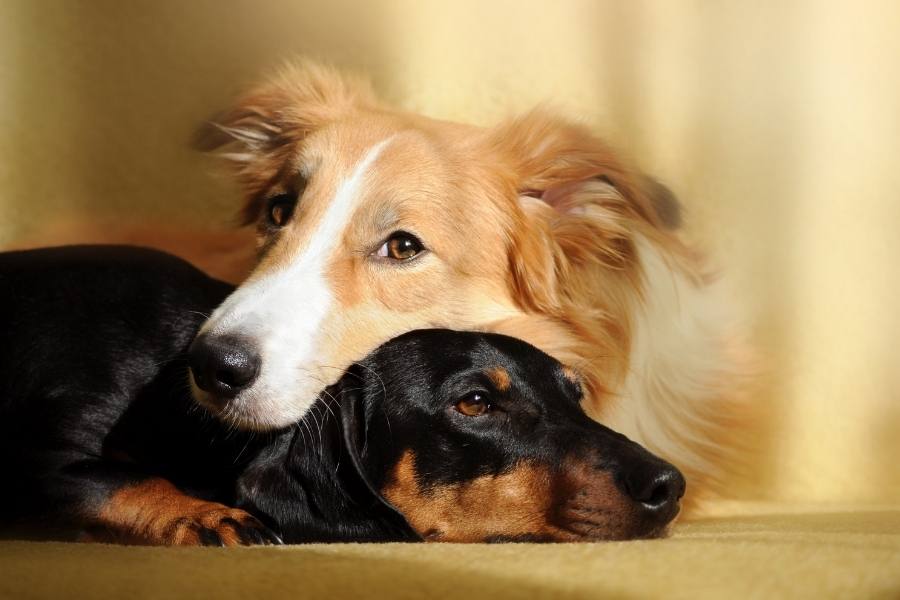
Tips and thoughts on working with dogs at home that fight
Always, always, always set your dogs up for success. Think through the situations that trigger fighting in your dogs. What can be done to diffuse tension or avoid confrontations?
If possible, work with someone who can help you navigate the steps involved with getting your dogs on a friendly (or at least neutral) footing again. This may be an experienced dog trainer, veterinarian, or canine behaviorist. Use sense and avoid “experts” who tell you to use physical threats and force with your dogs. This kind of approach may work, or it may get you – or someone else – badly hurt. A non-confrontational approach may take longer, but it is generally far safer, and doesn’t create new problems to replace the old ones.
Remember they’re just dogs. They’re reacting the only way they know how to stress, competition, pain (or whatever the case may be). They’re not doing it to stress you out or get back at you.
Realize that your emotions play a role. It’s important to realize that when tensions are high already, any additional tension or negative emotion from us can easily push our dogs into a fight. Which is not meant to make you feel even more stressed!
But have a plan for when you start feeling tense, angry, anxious (because you will). My suggestion is to just walk away from the dogs. Or – think a happy thought, sing a snippet of a favorite song, mentally plan a future vacation! However you do it, find a way to step away from your own tension about the situation. In doing so, you may be able to stop a dog fight before it starts.
Never assume. Preventing your dogs’ access to one another at problem times is crucial. Double-check personally to be sure that gates are up, doors are securely closed, leashes are handy, and that you know with 100% certainty where each dog is. You will not regret double-checking. You may regret if you don’t.
Forget timelines. This is not a process that can be rushed. It took time for your dogs to learn to dislike each other. It will take time for them to learn to accept each other again. It’s perfectly fine to proceed gradually; in fact, it’s usually better! My advice is to take it slower than you think you need to.
Plan for mistakes. Safeguards fail, people and dogs backslide. If a fight does happen, have a plan and know your options. What will you do if your dogs get at each other and a fight starts?
Among the various options, my personal preference is to simply walk away. Leave the room, leave the house, walk out of the yard – wherever the fight erupts: leave.
Is this easy? No. It’s extremely hard not to scream and yell and grab. But that’s why this method can work. Leaving the scene defuses the energy and intensity of the fight, rather than adding to it. Getting in there and freaking out all too often makes the fight worse, not better.
Once you hear that the fight has ended, get in and separate the dogs as calmly as possible.
Leaving the area is one option I have found to work well in many dog fight cases. Leaving is not an option if your dogs will injure one another even if you’re not present.
Look through the options below for stopping dog fights; maybe even print them out. I’m sure you’ll find some that should work for you and your dogs.
Wrapping Up
Having two dogs that want to fight is stressful on everyone in the home, people and dogs.
Although this is a dog behavior problem that’s much more easily solved if caught right away, I’ve certainly seen dedicated dog owners turn around even quite serious fighting among dogs at home. If you take proper precautions, and can work through some basic steps of reintroduction, many dogs that fight can learn to get along well again.
Natural supplements like flower essences can smooth the process of repairing your dog’s relationship by calming the intense emotions frequently seen in dogs at home that fight.
I hope this article has been helpful, not just in selecting Bach flower essences to help you resolve the issue of dogs fighting at home, but also to give you an idea of what’s involved in fixing the problem once it’s become serious.
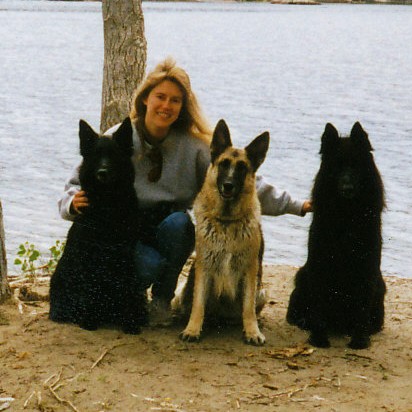
Julie Cantrell BSc is a professional dog trainer and canine behavior consultant who’s logged many thousands of hours training dogs and teaching owners since 1990. Flower essences have been part of her work with canine behavior since 1994. (bio)


